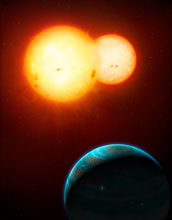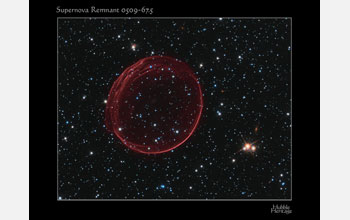All Images
News Release 12-007
New Class of Planets, Clues to Supernova Origins Announced
Researchers present new data and discoveries at AAS Meeting in Austin, Texas
This material is available primarily for archival purposes. Telephone numbers or other contact information may be out of date; please see current contact information at media contacts.

This is an artist's rendition of the Kepler-35 planet system, in which a Saturn-size planet orbits a pair of stars. The larger star is similar to the size of the Sun, while the smaller star is 79% of the Sun's radius.
The stars orbit and eclipse each other every 21 days, but the eclipses do not occur exactly periodically. This variation in the times of the eclipses motivated the search for the planet, which was discovered to transit the stars as it orbits the pair every 131 days. Similar events led to the discovery of the planet Kepler-34. The discovery of these two new systems establishes a new class of "circumbinary" planets and suggests there are many millions of such giant planets in our galaxy.
Credit: Mark A. Garlick / space-art.co.uk
Download the high-resolution JPG version of the image. (4 MB)
Use your mouse to right-click (Mac users may need to Ctrl-click) the link above and choose the option that will save the file or target to your computer.

This image shows that the central region of this supernova remnant, SNR 0509-67.5, is empty of stars, allowing researchers to rule out a number of possible models for the original supernova system. In this image, the stars appear as white dots on the black sky, while the red ring is gas ejected by the supernova eruption close to 400 years ago.
Credit: NASA, ESA, and The Hubble Heritage Team (STScI/AURA)
Download the high-resolution JPG version of the image. (221 KB)
Use your mouse to right-click (Mac users may need to Ctrl-click) the link above and choose the option that will save the file or target to your computer.
